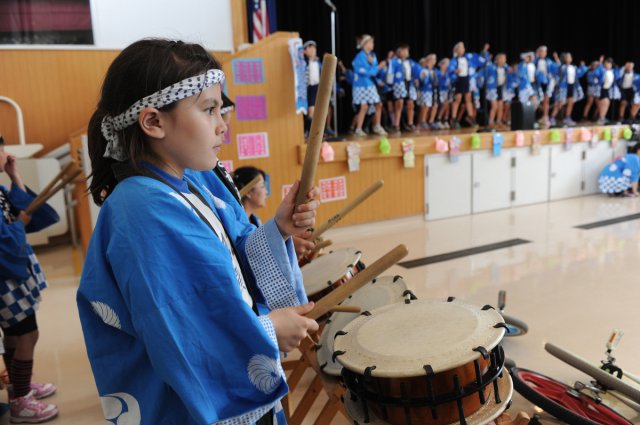Just like younger students, older kids can be intimidated by the idea of soloing. Breaking it down into its component steps makes it much easier to approach.
Soloing requires awareness of and ability to play on the beat (pulse), knowledge of form and strike, and competency with basic kuchishoka. Improvising adds a level of complexity that can throw off new players, so I recommend using the method below a couple times before opening the door to improvisation. The whole thing takes about 20 minutes.
Pair students up and give each team a piece of paper and pen. Have them draw a table with 2 rows and 4 columns on their paper.
Give students 5 minutes to create collaborative rhythm patterns using the kuchishoka they know, writing one kuchishoka in each cell in the table.
At the end of the 5 minutes, count them in and have all students say their patterns together in unison. Repeat 2-3 times, until everyone is saying their beats on the same pulse.
Have them say their patterns and play them simultaneously on their laps with their hands. Repeat 2-3 times.
Have students move to the drums and play/say in unison. Repeat 2-3 times.
Add a jiuchi. Repeat 2-3 times.
Have 4 drum teams remain standing while the others sit. Have these 8 students play their patterns one drum at a time (as soon as the first one finishes, the second starts, then the third, then the fourth).
Repeat Step 7 with different groups of 4 drums until every team has had a chance to play their pattern.
At this point, each team will have a duet that can be worked into a song arrangement. If time allows, repeat the whole process but let students create true solos rather than working in teams. Alternately, you can just let them work as true soloists from the beginning if you time/equipment/space allows.
For this method to work, students need 1) to understand the jiuchi and how it supports unison playing 2) to understand basic kuchishoka and 3) to know a song structure they can plug a solo in to (Sanae Swing, Matsuri, or the alphabet/ostinato activity would all work). If they don’t have those building blocks, spend some time on them before moving to soloing.
Let me know if you have any questions about this method. Happy teaching!
(Interested in teaching other ages to solo? Here’s the post on teaching younger students; here’s one about teaching adults; and here’s a game that makes practicing this skill fun for all ages!)







